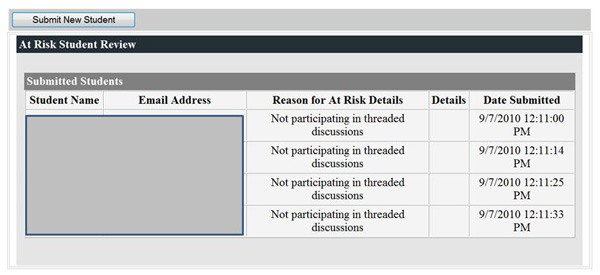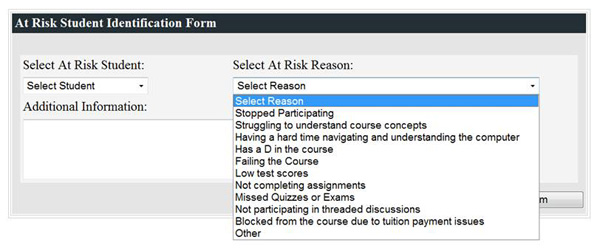Key Takeaways
- Community colleges, already coping with stringent limitations on resources and low degree completion rates among students, face the additional strain of increasing student numbers as unsuccessful job seekers return to school for more training.
- The Iowa Community College Online Consortium turned to analytics to identify at-risk students so that educators could intervene and offer customized support to struggling students.
- Between fall 2005 and fall 2007, at-risk student success rates among the ICCOC schools rose nine percent, and course completion rates rose from 77 percent to 82 percent, demonstrating the effectiveness of the analytics-enabled interventions.
Despite living in an era in which a postsecondary degree or certification is required for a growing number of jobs — and is positively correlated with factors such as civic engagement and physical health — 30 percent of U.S. college students drop out before their second year, and 50 percent of college students never graduate.1 Among community college students, just 28 percent complete a degree within three years.
With unemployment still high in many areas of the country, many job seekers are returning to school for additional training. The increase in numbers of students puts additional strain on community colleges, which is where many adult learners choose to further their education. Nevertheless, even among this population, only about half earn degrees.2
The nation's workforce and competitiveness stand to suffer if the retention and completion rates of college students cannot be increased. Colleges and universities must pursue strategies to identify at-risk students and ensure they earn the degrees they want and need for lifetime success.
Online Learning at Community Colleges in Iowa
Formed in 1999, the Iowa Community College Online Consortium (ICCOC) includes nine community colleges that partner to provide online education to their students. The consortium includes the Eastern Iowa Community College District (Clinton, Muscatine, and Scott Community Colleges), Iowa Lakes, Iowa Western, Northwest Iowa, Southeastern, Southwestern, and Western Iowa Tech. The ICCOC delivers a wide variety of online courses and 11 fully online degrees to students across the state of Iowa.
Like many institutions, the ICCOC faced the challenge of improving the way in which it identified at-risk students. In 2007, 40 percent of students were new to online learning and unfamiliar with the self-discipline needed to perform well in this environment. At that time, just 77 percent of at-risk students completed their courses, and of those, only 57 percent got a grade of "C" or higher.
The ICCOC set three main goals:
- Quickly identify at-risk students to make changes before students fail or drop out
- Provide learning support for students who need it
- Increase student success rates
Using the Tools Technology Provides
Connecting analytics to achievement has become a critical component of success, both for institutions and for students. Through learning management systems and other computing systems on campus, colleges and universities have access to an enormous amount of data that can be correlated with student outcomes. When institutions compare student achievement with class performance trends over time, the patterns that surface can provide a lens on which students are at risk so that appropriate steps can be taken to improve their odds of success.
Analytics technology tools that deliver insight into the performance of students are especially important to the success of an institution's online programs because of the additional complexity in monitoring students in e-learning courses. These tools allow schools to identify, track, and target specific areas for improvement related to student achievement and success, and they give institutions important data for effective change management of online courses.
By using tools that allow for real-time measurement of student performance, institutions have a window into how well students are learning and the likelihood of their succeeding. Being able to access this kind of information enables administrators to quickly and easily identify areas for student engagement and improvement.
Measurement and Analytics at the ICCOC
The ICCOC wanted to increase its student success rate to 85 percent. To accomplish this goal, the consortium committed itself to a program of early identification of at-risk students. The ICCOC created an administrative role to target these students and develop a plan for appropriate interventions to minimize attrition. Despite good intentions, however, the tools available at that time to accomplish these goals were limited. At-risk reporting was done manually — the consortium gathered course- and program-specific data only from a student information system. This cumbersome process resulted in delayed response time to students' possible performance problems, slowing administrators' ability to intervene and thus handicapping the consortium's efforts to improve the success rates — as measured by student completion of their course and earning a grade of C or higher — of at-risk students.
To increase the efficiency and effectiveness of this process, administrators turned to the ICCOC's online learning platform, Pearson LearningStudio. Within this platform, an Enterprise Reporting suite allowed the ICCOC to automate the formerly manual process. The application produces a student activity report that displays the time individual students spend within a specific course or across the program's entire offering, either in weekly snapshots or over longer periods of time. Administrators identified specific metrics that correlated with student success or failure, and they established parameters for those metrics that would trigger certain interventions. Figure 1 shows an at-risk student identification form that an instructor can use to identify the reasons a student in his or her course might be at risk. Figure 2 shows an at-risk student review for four students within a course whom the instructor flagged as not participating in threaded discussions. For example, inactive students — those who hadn't logged into their courses — were identified as "at risk for failure." With more efficient data trending and reporting, the consortium educators had sufficient opportunity to intervene and guide students back to success.

Figure 1. At-Risk Student Identification Form

Figure 2. At-Risk Student Review
Students were also identified as at-risk if they enrolled after the course start date, failed the course during a previous semester, or enrolled in more than four online courses at one time. Communication with students occurred in a noninvasive manner via e-mail. The ICCOC Student Services Manager checked-in regularly with students to ensure their questions were answered and their technology was working, and to provide tips, tricks, and information about online student services.
The ICCOC also uses a course communication tool that allows instructors to notify program administrators of at-risk behavior among their students after the course started. This tool, available in every ICCOC course, provides instructors with a roster of students, a list of reasons for concern, and a text box for additional information. Reasons for an instructor to report the student as at-risk include: failing an assessment, nonparticipation in class discussion, not completing assignments, or having difficulty navigating the course. A freeform text box is available to provide additional information to staff, such as whether a student telephone is disconnected or e-mail address is undeliverable. With these functions, the ICCOC can collect relevant data at a much earlier point, identify at-risk students sooner, and intervene and guide those students toward more successful learning paths.
Outcomes and Lessons Learned
Using analytics tools tied to its online learning platform, the ICCOC was able to increase the student success rate for at-risk students by nine percent between fall 2005 and fall 2007. At the same time, at-risk students' course completion rates increased from 77 percent to 82 percent. In fall 2009, at-risk students' course completion reached 85 percent, and their success rate reached 62 percent. The analytics and measurement tool has enabled ICCOC administrators to monitor daily performance trends, identify troubled students, and provide assistance in time to help them succeed. As a result, the consortium is moving closer to its goal of an 85 percent student success rate. Table 1 shows the initiative's progress.
Table 1. At-Risk Students' Course Completion and Success Rates
| Fall 2005 | Fall 2006 | Fall 2007 | Fall 2008* | Fall 2009 | |
| At-Risk Students' Course Completion | 77% | 75% | 82% | 77% | 85% |
| At-Risk Students' Success (completers who earned a grade of C or higher) | 57% | 60% | 66% | 55% | 62% |
* The addition of 8-week courses at the request of college administrations (previously only 16-week semesters were offered), staff turnover, and significant growth with no staffing increase all contributed to a drop in completion and success rates in 2008.
Having the right technology tools in place can provide valuable information at the right time to effectively guide actions to improve retention and success in college courses. Institutions like the ICCOC can proactively target their intervention, communication, professional development, and operational planning to areas where they have the greatest potential for improving student success.
The ICCOC learned several important lessons from this analytics project that have transformed its online programs to build a culture of insightful assessment:
- Monitor and act on key performance indicators. When red flags arise, take appropriate action and make adjustments.
- Define consistent and organized learning outcomes for students to attain. Students need consistency and clear-cut examples of what faculty are looking for and what constitutes success.
- Set the optimal pace for each student to succeed by providing customized and appropriate learning paths guided by performance data. This speaks to an emerging initiative called Learning Paths. Learning Paths allows an instructor to develop and customize learning based on student performance within a chapter or unit. A student requiring remediation in a chapter will take a path different from that of a student who demonstrates mastery.
- Collect, provide feedback on, and score student success. You can only improve what you measure.
- Consistently evaluate teaching and learning, and continuously collect and assess student feedback on well-documented and overlooked topics. Well-documented student feedback includes response time (the need for instructors to provide feedback within 24 hours), and course navigation and design. Overlooked topics would be any student feedback on an issue of which we are not aware. We conduct student surveys at the end of every semester so that changes can be made when necessary.
Refinements and enhancements are part of an ongoing process. Reporting has become automated so that key stakeholders have more immediate access to reports. We continue to review and revise how we define an at-risk student. In the future we plan to provide instructors with an easy-to-understand dashboard so that they can more effectively identify and assist at-risk students in their course.
With the right tools, technology, and culture in place, institutions can increase student retention and help more students complete their degrees. The measurement and analytics program at the ICCOC emerged as a comprehensive solution to efforts to improve student performance. Institutions seeking similar results for their students might consider investing in tools that give administrators the ability to monitor daily performance trends, identify troubled students, and provide appropriate assistance when it can be most effective.
- College in America [infographic], posted August 28, 2010, on Holy Kaw! All the topics that interest us, Alltop.com.
- Natalia Kolesnikova, "Community Colleges: A Route of Upward Economic Mobility," Federal Reserve Bank of St. Louis, March 2009, p. 6.
© 2010 Matt Leavy and Steve Rheinschmidt. The text of this article is licensed under the Creative Commons Attribution-Noncommercial-No Derivative Works 3.0 license.
